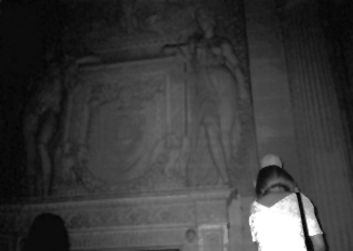The Haunting of Hallmore
Linn: When Ellis and Dorey Hargrave bought their house on the outskirts of Lindon in 1968, they hoped for a long and comfortable life there. And although they still live in the house, it is only recently that their life has become as peaceful as they thought it would.
Elderly neurosurgeon Ellis Hargrave recalls purchasing the house. "I'd heard stories of Hallmore's past elegance, and I wanted to see if I could restore it. I was making way too much money at that time as a neurosurgeon, and thought that this would be a worthwhile project. And a big one, too. No one had lived in Hallmore for eighty years." Records support Hargrave's statement. The mansion was built on thirty acres in 1840 by a man named Daniel Cane, where he lived until his disappearance in 1867. Cane had left no will, and had no heirs, so the county assumed the property, sold off all but three acres to nearby farmers, and let the house sit as an empty shell.
Then, in 1965, the county assessed its holdings once again, and decided to sell Hallmore to the public. Though the asking price was only $10,000 dollars, Hallmore's decrepitude prevented successful sale until 1968, when Hargrave purchased the title.
Dorey Hargrave recalls stepping through Hallmore's doors for the first time. "The mansion was in bad shape, of course, and smelled like mildew and rot and dust. But there were other smells, too: wet fur and of tomcat urine. Wholly disagreeable." Renovation began right away. Much of the expense went to refurbishing art treasures that Daniel Cane had imported from all over the world, including an 18th century neoclassical fireplace and jade statuettes from Laos. It took the Hargraves a full year and over $27,000 to restore the 20 room mansion. But trouble lurked just around the corner.
It was in 1966 that the Hargraves first experienced the spectral phenomena in their home. They were sitting in front of the living room fireplace on a cold winter's night, reading. Suddenly, knickknacks and vases on a nearby shelf wobbled and crashed to the floor. The couple shrugged this incident off as the house settling.
Then, in July of that year, while sitting in the living room, they distinctly heard a scratching sound coming from near a window. They investigated, and saw the bottom of one of the drapes fraying violently right before their very eyes!

Hannah McDougal examines the massive 18th century fireplace that led into the bowels of Hallmore Mansion.
In 1987, Ellis conducted a full study of the house's origins and the enigmatic Daniel Cane. Cane was once a wealthy surgeon and veterinarian from Boston who had moved to Iowa after making his fortune through twenty years of highly skilled work. Though wealthy, Cane continued his veterinary practice in Lindon until the failing quality of his work forced him to retire at age 57. More importantly, Cane reportedly belonged to the Milieu d'Or, or Society of Gold, an organization similar to the Bavarian Illuminati (see: Henri Lemarchand's Fate Worse Than Death, November, 1996, vol 3, Issue #10).
Ellis then began a thorough investigation of the living room, down to the smallest crack. At the very back of the fireplace, at the base of the flue, he found a stone protruding ever so slightly beyond the others. He knew what this meant immediately. Sure enough, when he pulled, the heavy fireplace swung out away from the wall on massive hidden hinges. Beyond was a small alcove, with earthen steps leading down. He retrieved a flashlight and proceeded into this secret basement.
"The smell was atrocious," he says. "Urine, faeces, wet hair---awful. It was like all those other things we'd experienced in the living room, but more powerful. The stairs dropped about twenty feet, I'd say, and ended at a curtain. Beyond was an earthen chamber about twenty feet by twenty feet. There was only one distinctive and horrid feature in the room: the far wall was covered with cat and dogs hides stitched together and drawn taut. Only a five foot by three foot section was left uncovered where all kinds of symbols and lines not unlike that stuff on the cover of your magazine were chiseld into the wall. I probably should have gotten my camera and taken a picture, but I was too disgusted and horrified. How could these skins still have been there? They hadn't rotted away since Cane put them there, and I know he did it."
Hargrave disposed of the skins and obliterated the writing on the wall. The purpose of the mysterious room is anyone's guess. Since its discovery, most ghostly phenomena has stopped. Yet on some nights, when the couple is alone, they will feel a slight pressure on their laps and hear a soft, almost inaudible purr.
Back to this Issue Contents
